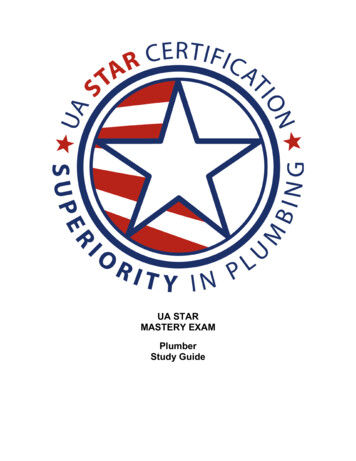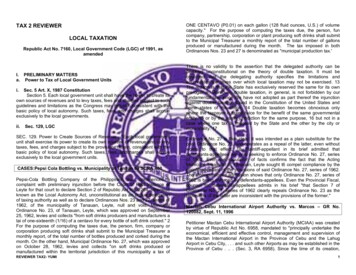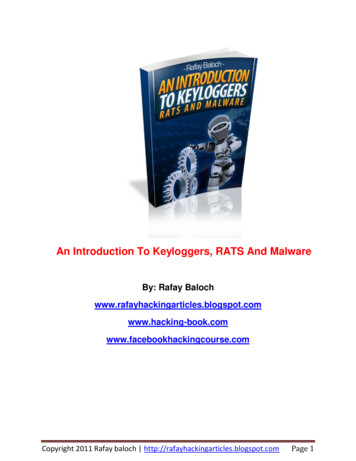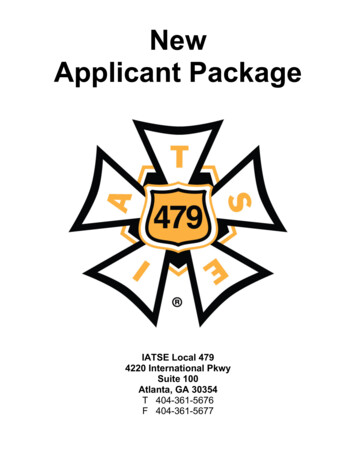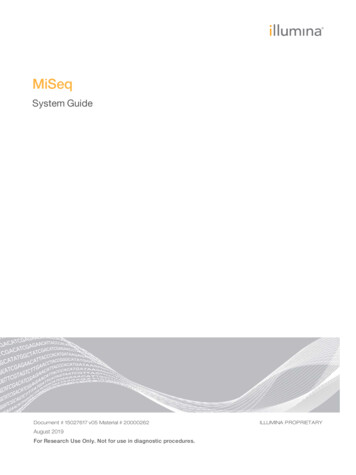
Transcription
MiSeqSystem GuideDocument # 15027617 v05 Material # 20000262August 2019For Research Use Only. Not for use in diagnostic procedures.ILLUMINA PROPRIETARY
MiSeq System GuideThis document and its contents are proprietary to Illumina, Inc. and its affiliates ("Illumina"), and are intended solely forthe contractual use of its customer in connection with the use of the product(s) described herein and for no otherpurpose. This document and its contents shall not be used or distributed for any other purpose and/or otherwisecommunicated, disclosed, or reproduced in any way whatsoever without the prior written consent of Illumina. Illuminadoes not convey any license under its patent, trademark, copyright, or common-law rights nor similar rights of any thirdparties by this document.The instructions in this document must be strictly and explicitly followed by qualified and properly trained personnel inorder to ensure the proper and safe use of the product(s) described herein. All of the contents of this document must befully read and understood prior to using such product(s).FAILURE TO COMPLETELY READ AND EXPLICITLY FOLLOW ALL OF THE INSTRUCTIONS CONTAINED HEREIN MAYRESULT IN DAMAGE TO THE PRODUCT(S), INJURY TO PERSONS, INCLUDING TO USERS OR OTHERS, AND DAMAGETO OTHER PROPERTY, AND WILL VOID ANY WARRANTY APPLICABLE TO THE PRODUCT(S).ILLUMINA DOES NOT ASSUME ANY LIABILITY ARISING OUT OF THE IMPROPER USE OF THE PRODUCT(S)DESCRIBED HEREIN (INCLUDING PARTS THEREOF OR SOFTWARE). 2018 Illumina, Inc. All rights reserved.All trademarks are the property of Illumina, Inc. or their respective owners. For specific trademark information, seewww.illumina.com/company/legal.html.Document # 15027617 v05 Material # 20000262For Research Use Only. Not for use in diagnostic procedures.ii
Revision HistoryDocument #DateDescription of ChangeMaterial # 20000262Document # 15027617 v05August2019Updated index cycle information.Corrected material number.Material # 20000262Document # 15027617 v04July2018Added new run configuration options for Local Run Manager,Sample Sheets, and Manual sequencing modes.Replaced references to MiSeq Reporter with Local RunManager.Added Resolve Chiller Temperature Ranges toTroubleshooting Appendix.Material # 20000262Document # 15027617 v03May2018Removed the default user name and password required tolog on to the operating system. Illumina recommends usingsite-specific credentials.Added information about the Illumina Proactive monitoringservice in the Customize System Settings section.Added note to Reagent Compartment regarding requiredchiller temperature range.Added back MiSeq Reporter and removed references toLocal Run Manager.Changed the name of the guide from the MiSeq SequencingSystem Guide to the MiSeq System Guide.Minor text edits.Material # 20000262Document # 15027617 v02January2018Added new run configuration options for Local Run Manager,Sample Sheets, and Manual sequencing modes.Replaced references to MiSeq Reporter with Local RunManager.Added Resolve Chiller Temperature Ranges toTroubleshooting Appendix.Added new instruction for collecting instrument performancedata in the Customize System Settings topic.Changed the name of the guide from the MiSeq SystemGuide to the MiSeq Sequencing System Guide.Document # 15027617 v05 Material # 20000262For Research Use Only. Not for use in diagnostic procedures.iii
MiSeq System GuideDocument #DateDescription of ChangeMaterial # 20000262Document # 15027617 v01September2015Changed the name of the guide from the MiSeq System UserGuide to the MiSeq System Guide.New in MCS v2.6, added BaseSpace Onsite information.Rearranged guide information to center around tasks ratherthan screens.All references to the Welcome screen are changed to theHome screen.Added information that is in the MiSeq Reagent Kit ReagentPrep Guides, including flow cell types, reagent cartridgecontents, and directions for thawing the reagent cartridge.Visit the Illumina website for all other MiSeq Reagent Kitinformation atsupport.illumina.com/sequencing/sequencing kits/miseqreagent kit.html.Corrected the expected wash volume of a maintenancewash from 17.25 ml to 51.75 ml.Updated the order of workflow steps to first prepare thereagent cartridge, and then if required, denature and dilutelibraries.Moved troubleshooting information to Appendix A.Moved output folder information and flow cell tile informationto Appendix B.Moved information on managing files to the Maintenancechapter.Moved the post-run wash instructions from the Maintenancechapter to the Sequencing chapter.The name of the Performing a Run chapter is nowSequencing.Changed references from primary analysis to analysis byRTA software.Updated the dilution directions for the post-run washprocedure with a template line wash from 6% NaOCl to 5%NaOCl.Added an NaOCl, 5% part number to the user-suppliedconsumables list.Part # 15027617 Rev. OSeptember2014Updated the following information: New in MCS v2.5, updated post-run wash option toinclude a template line wash Updated directions for a post-run wash with sodiumhypochlorite to the template line wash Added the expected wash volume for a post-run washesAdded VeriSeq PGS workflow information regardingadditional resources, run options, secondary analysisoptions, instrument washes, and flow cell cap color.Part # 15027617 Rev. NJune 2014Added information applicable to the VeriSeq PGS workflow.Updated run metrics information for cluster generation anddensity.Removed anti-virus software information. See MiSeq SystemSite Preparation Guide .Document # 15027617 v05 Material # 20000262For Research Use Only. Not for use in diagnostic procedures.iv
MiSeq System GuideDocument #DateDescription of ChangePart # 15027617 Rev. MJanuary2014Updated to change introduced in MCS v2.4:Added bundle logs feature for sending troubleshooting files.Part # 15027617 Rev. LOctober2013Added the reboot of system software as a pre-run step.Added microcentrifuge tubes to the list of user-suppliedconsumables.Eliminated MiSeq Software as a separate chapter anddistributed chapter contents throughout the guide.Removed information about folders for custom recipes.Removed information about recommended cluster densityranges for MiSeq reagent kits.Removed details about MiSeq reagent kits and added anoverview of reagent kit features. For detailed information, seethe reagent prep documentation for the kit you are using.Added content to the trademarks notice.Part # 15027617 Rev. KAugust2013Corrected formatting errors.Part # 15027617 Rev. JAugust2013Added run descriptions for MCS v2.3 and MiSeq Reagent Kitv3.Updated the following information: Reagent kit and version compatibility to include MiSeqReagent Kit v3 Custom Recipes folder description to include a v3subfolder Changed cluster density range for v2; added range for v3 Output path for image filesCorrected flow cell bar codes for nano flow cells (D) andmicro flow cells (G).Removed information about MiSeq Reagent Kit, includingcontents and flow cell types. For more information, seeMiSeq Reagent Preparation Guide (document # 15044983) .Part # 15027617 Rev. HMarch2013Added section titled MiSeq Concepts that introduces theanalysis workflow, manifest file, and sample sheet.Removed information about FASTQ file generation, manifestfile formats, analysis workflow details, and sample sheetdetails. For information about these topics, see the MiSeqReporter User Guide , part # 15028784, or the MiSeq SampleSheet Quick Reference Guide , part # 15028392.Removed instructions for preparing custom primers. For moreinformation, see Using Custom Primers on the MiSeq, part #15041638.Document # 15027617 v05 Material # 20000262For Research Use Only. Not for use in diagnostic procedures.v
MiSeq System GuideDocument #DateDescription of ChangePart # 15027617 Rev. GJanuary2013Removed instructions for denaturing and diluting DNAlibraries and preparing an Illumina PhiX control. SeePreparing DNA Libraries for Sequencing on the MiSeq, part #15039740.Updated instrument wash instructions to add 25 ml 10%Tween 20 to 475 ml laboratory-grade water, instead of 500ml laboratory-grade water.Part # 15027617 Rev. FNovember2012Added the following new information: Added kit descriptions for new MiSeq reagent kits: MiSeqReagent Nano Kit and MiSeq Reagent Micro Kit Added overview of flow cell types Added description of Enrichment analysis workflowUpdated the following information: New in MCS v2.1, updated Perform Wash screen to add apost-run wash option and command to raise sippers Updated version compatibility table to include nano andmicro kit dependencies Updated version compatibility information to include newreagent kitsPart # 15027617 Rev. EOctober2012Updated the following information: Corrected PhiX control preparation instructions andexpected cluster density of prepared PhiX control to 1000–1200 K/mm² Noted that the procedure for denaturing and dilutinglibraries, Preparing Your Libraries, does not apply toNextera XT libraries as well as TruSeq Amplicon libraries Changed upgrade name from MiSeq Expansion Pack toMiSeq hardware upgrade Add the MiSeq Reporter User Guide to AdditionalResources list.Document # 15027617 v05 Material # 20000262For Research Use Only. Not for use in diagnostic procedures.vi
MiSeq System GuideDocument #Part # 15027617 Rev. DDateJuly 2012Description of ChangeUpdated software descriptions to MCS v2.0.Added the following new information: Added a section titled What's New in MCS to describe newsoftware features, interface changes, and workflowchanges Added catalog number and description of the MiSeqReagent Kit v2, 500 Cycles Added Version Compatibility and Requirements section Added description of MiSeq Expansion Pack, which isrequired for 14-tile dual-surface flow cell imaging Added description of dual-surface flow cell tile numbering Added the PCR Amplicon analysis workflow for Nextera XTlibraries Added the use of 10% Tween 20 in wash procedures andexpected wash volumes Added the reagent cartridge version to the RFID readfailure procedureUpdated the following information: Changed reagent acronyms for IMF, CMF, and AMX to v2reagent names IMS, CMS, and AMS, respectively Changed the PhiX concentration from 8 pM to 12.5 pM Changed the maximum recommended NaOHconcentration to 1 mM in final solution Noted that a maintenance wash is required to remove theinstrument from standby mode and begin the setup stepsfor a subsequent run Removed Sample Sheet Parameters section and samplesheet setup step in the workflow; Illumina recommendscreating the sample sheet prior to sample preparation (Seethe MiSeq Sample Sheet Quick Reference Guide , part #15028392 and the Illumina Experiment Manager UserGuide , part # 15031335).Document # 15027617 v05 Material # 20000262For Research Use Only. Not for use in diagnostic procedures.vii
MiSeq System GuideDocument #DateDescription of ChangePart # 15027617 Rev. CApril 2012Updated software descriptions to MCS v1.2Added the following new procedures and sections:BaseSpace overview, Using Custom Primers, GeneratingFASTQ files, Troubleshooting Flow Rate Error, Performing aVolume Test, Performing a Maintenance Wash, and Idlingthe Instrument, which includes a standby wash.Updated the following information: Updated name of Amplicon workflow to Custom Amplicon;updated name of DenovoAssembly workflow to Assembly;added GenerateFASTQ workflow Added descriptions of run folders and files; updated runfolder naming; added output file size Listed genome folder as required for amplicon sequencingin Sample Sheet Parameters Added instructions for diluting NaOH to denature libraries Updated Resolving RFID Read Failure to include MiSeqSelf-Service instructions Listed files and folders used for troubleshooting runperformancePart # 15027617 Rev. BDecember2011Updated software descriptions to MCS v1.1Added information about anti-virus protectionUpdated the following information: Instructions to resolve RFID failure Preparing libraries—Changed to 0.2 N NaOH Run folder naming convention Required disk space and storage capacity Run setup steps—Added more information to Setting Upthe Sample Sheet Run setup steps—Added note to dispose of remaining PR2 Analysis duration—Added when analysis exceeds twohours Analysis Input Requirements—Listed manifest files asrequired for TruSeq Custom Amplicon libraries Corrected HT1 tube size in MiSeq Reagent Kit Contents Changed iCom references to MyIlluminaPart # 15027617 Rev. ASeptember2011Initial releaseDocument # 15027617 v05 Material # 20000262For Research Use Only. Not for use in diagnostic procedures.viii
Table of ContentsChapter 1 Overview1IntroductionAdditional ResourcesComponentsMiSeq ConceptsSystem SoftwareSecondary Analysis OptionsSequencing Analysis ViewerRequired Disk SpaceMiSeq Reagent Kit Overview112456888Chapter 2 Getting StartedStart the MiSeqCustomize System SettingsConfigure Notifications of BaseSpace UpdatesSet Email PreferencesSet Default Folder LocationsUser-Supplied ConsumablesChapter 3 SequencingIntroductionRun DurationMiSeq WorkflowThaw Reagent CartridgeInspect the Reagent CartridgeDenature and Dilute LibrariesLoad Sample LibrariesSet Up a Run Using MCSClean the Flow CellLoad the Flow CellLoad ReagentsStart the RunMonitor the RunPerform a Post-Run WashChapter 4 MaintenanceMaintenance FrequencyMaintenance Frequency for the VeriSeq PGS WorkflowPerform a Maintenance WashPerform a Standby WashManage FilesSoftware UpdatesShut Down the InstrumentDocument # 15027617 v05 Material # 20000262For Research Use Only. Not for use in diagnostic 627293333333336383939ix
MiSeq System GuideAppendix A TroubleshootingIntroductionBundle Logs for TroubleshootingPerform a System CheckPause or Stop a RunRaise Reagent Cartridge Sippers ManuallyResolve Run Setup ErrorsResolve RFID Read FailurePerform a Volume TestMeasure Expected Wash VolumesResolve Reagent Chiller Temperature ErrorsResolve Local Run Manager Analysis ErrorsConfigure System SettingsAppendix B Output Files and FoldersRun FoldersMiSeqOutput Folder ContentsRTA Folders and nical Assistance55Document # 15027617 v05 Material # 20000262For Research Use Only. Not for use in diagnostic procedures.x
Chapter 1 OverviewIntroductionAdditional ResourcesComponentsMiSeq ConceptsSystem SoftwareSecondary Analysis OptionsSequencing Analysis ViewerRequired Disk SpaceMiSeq Reagent Kit Overview112456888IntroductionThe Illumina MiSeq system combines proven sequencing by synthesis (SBS) technology with arevolutionary workflow that lets you go from DNA to analyzed data in as few as eight hours. The MiSeqintegrates cluster generation, sequencing, and data analysis on a single instrument.FeaturesuWalk away automation—After setting up your run, which includes loading the pre-filled reagent cartridge,buffer bottle, and flow cell, no additional hands-on time is required.uPrefilled reagent cartridge—A specially designed single-use prefilled reagent cartridge provides reagentsfor cluster generation and sequencing, including paired-end sequencing reagents and indexing reagents.Integrated radio-frequency identification (RFID) tracking enables accurate consumable tracking.uInterface controls—The MiSeq Control Software (MCS) interface provides controls to configure theinstrument, set up and monitor runs, and perform maintenance procedures.uConvenient flow cell loading—A clamping mechanism auto-positions the flow cell as it is loaded onto theinstrument. Integrated radio-frequency identification (RFID) tracking enables accurate consumabletracking.uInnovative fluidics architecture—The MiSeq fluidics system enables unmatched efficiency in chemistrycycle time during sequencing.uReal-time analysis (RTA)—Integrated analysis software performs real-time on-instrument data analysisduring the sequencing run, which includes image analysis and base calling, and saves valuabledownstream analysis time.uLocal Run Manager— Integrated secondary analysis software processes data from analysis by RTA toperform alignment and provides information about each sample analyzed.Additional ResourcesThe MiSeq system support pages on the Illumina website provide additional resources. These resourcesinclude software, training, compatible products, and the following documentation. Always check supportpages for the latest versions.Document # 15027617 v05 Material # 20000262For Research Use Only. Not for use in diagnostic procedures.1
MiSeq System GuideResourceDescriptionMiSeq System Site PrepGuide (document #15027615)Provides specifications for laboratory space, electrical requirements, and environmentalconsiderations.MiSeq System Safety andCompliance Guide(document # 15027616)Provides information about instrument labeling, compliance certifications, and safetyconsiderations.Illumina ExperimentManager User Guide(document # 15031335)Provides instructions for creating sample plates and sample sheets for different workflowsand library types.BlueFuse WorkflowManager User Guide(document #1000000028842)Provides instructions for creating sample plates and sample sheets for use with theVeriSeq PGS workflow.MiSeq Sample SheetQuick Reference Guide(document # 15028392)Provides information about adding sample sheet settings to your sample sheet.MiSeq System Denatureand Dilute Libraries Guide(document # 15039740)Provides instructions for denaturing and diluting prepared sample libraries beforesequencing on the MiSeq, and preparing a PhiX control. This step applies to most librarytypes.MiSeq Custom PrimersGuide (document #15041638)Provides instructions for preparing and loading custom primers, and editing the samplessheet for custom primers.Local Run ManagerSoftware Guide (document# 1000000002702)Provides an overview of the Local Run Manager software, instructions for using softwarefeatures, and instructions for installing analysis modules on the instrument computer.BlueFuse Multi SoftwareGuide (document #15053620)Provides a comprehensive overview of analysis procedures, analysis workflows, and filesgenerated by BlueFuse Multi, as well as computing requirements, and troubleshootinginformation. Use this guide with the VeriSeq PGS workflow.BaseSpace User Guide(document # 15044182)Provides instructions for using BaseSpace and descriptions of the graphs generated foreach analysis workflow.BaseSpace Onsite SystemGuide (document #15049148)Provides instructions for using the BaseSpace Onsite System.ComponentsThe MiSeq comprises a touch screen monitor, a status bar, a power button with adjacent USB ports, andthree compartments.Document # 15027617 v05 Material # 20000262For Research Use Only. Not for use in diagnostic procedures.2
MiSeq System GuideA Flow cell compartment—Contains the flow cell stage that houses the flow cell throughout the run. Flow cellstage motors move the stage out of the enclosed optical module for flow cell loading and returns the stagewhen the run begins.B Enclosed optics compartment—Contains optical components that enable imaging of the flow cell.C Status bar—Indicates flow cell status as ready to sequence (green), processing (blue), or needs attention(orange).D Touch screen monitor—Displays the control software interface for system configuration and run setup.E External USB ports—Facilitates the transfer of files and data to the instrument computer from the touchscreen monitor.F Reagent compartment—Contains reagents at proper temperatures, wash solutions, and a bottle for usedreagents. A magnetic latch secures the reagent compartment door.The MiSeq interface guides you through the run setup steps using the touch screen monitor. Loading runcomponents requires access to the reagent compartment and the flow cell compartment.Flow Cell CompartmentThe flow cell compartment contains the flow cell stage, thermal station, and fluidics connections to the flowcell. The flow cell stage holds the flow cell and the flow cell clamp secures and positions the flow cell. Whenthe flow cell clamp closes, two pins near the clamp hinge auto-position the flow cell.The thermal station, located beneath the flow cell stage, controls changes in flow cell temperature requiredfor cluster generation and sequencing.Figure 1 Flow Cell CompartmentABCDEFlow Cell StageFlow Cell Compartment DoorFlow Cell ClampFlow CellFlow Cell Clamp Release ButtonReagent CompartmentThe reagent compartment contains the reagent chiller, and positions for the wash buffer (PR2) bottle and thewaste bottle. To maintain a consistent temperature, open and close the reagent chiller only when instructed.NOTEThe required temperature range of the reagent chiller is 2 C to 11 C.Document # 15027617 v05 Material # 20000262For Research Use Only. Not for use in diagnostic procedures.3
MiSeq System GuideDuring the run, the reagent chiller holds a single-use reagent cartridge. During the instrument wash, thereagent chiller holds the wash tray. The software automatically lowers sippers into each reservoir of thereagent cartridge at the appropriate time during a run depending on the process being performed.To the right of the reagent chiller are form-fitted slots for the PR2 bottle and the waste bottle. The sipperhandle locks the bottles in place and lowers the appropriate sipper into each bottle. Reagents are pumpedthrough the sippers and fluidics lines, and then to the flow cell. Reagent waste is delivered to the waste bottlethroughout the process.Figure 2 Reagent Compartment ComponentsABCDEReagent ChillerSipper Handle (shown in raised position)PR2 BottleWaste BottleReagent CartridgeMiSeq ConceptsThe following concepts and terms are common to the run setup steps on the MiSeq.ConceptDescriptionAnalysis WorkflowA secondary analysis procedure is performed by Local Run Manager. The analysisworkflow for each run is specified in the sample sheet or by the selected module.ManifestThe file that specifies a reference genome and targeted reference regions to be used inthe alignment step. For workflows that require a manifest, the manifest file is specified inthe sample sheet and copied to the manifest folder designated in MCS. Manifest files canalso be loaded in Local Run Manager for use during secondary analysis.Reference GenomeA FASTA format file that contains the genome sequences used during analysis. For mostanalysis workflows, the reference genome file is specified in the sample sheet.Run FolderThe folder structure populated by RTA software (MiSeqOutput folder) or the folderpopulated by Local Run Manager (MiSeqAnalysis). For more information, see Run Folderson page 47.Sample SheetA comma-separated values file (*.csv) that contains information used to set up andanalyze a sequencing run, including a list of samples and their index sequences.The sample sheet can be provided during the run setup steps on the MiSeq. After the runbegins, the sample sheet is renamed to SampleSheet.csv and copied to the run folders:MiSeqTemp, MiSeqOutput, and MiSeqAnalysis.Document # 15027617 v05 Material # 20000262For Research Use Only. Not for use in diagnostic procedures.4
MiSeq System GuideFor more information on analysis workflows and manifest file formats, see the Local Run Manager SoftwareGuide (document # 1000000002702).For more information on sample sheets, see the MiSeq Sample Sheet Quick Reference Guide (document #15028392).System SoftwareThe instrument software suite includes integrated applications that perform sequencing runs, on-instrumentanalysis, and related functions.uMiSeq Control Software (MCS)—Controls instrument operation. The MiSeq Control Software (MCS)interface guides you through the steps to load the flow cell and reagents before beginning the run. Anoverview of quality statistics appears as the run progresses.uDuring the run, MCS operates the flow cell stage, dispenses reagents, controls flow cell temperatures,and captures images of clusters on the flow cell. MCS performs the run according to parametersspecified in the Local Run Manager software.uReal-time analysis (RTA) software—Performs image analysis and base calling, and assigns a quality scoreto each base for each cycle. Images are temporarily stored in the run folder for processing by RTA, andthen automatically deleted when analysis by RTA is complete.uLocal Run Manager—An on-instrument integrated solution used to create a run, monitor status, analyzesequencing data, and view results. Local Run Manager also tracks sample information and controls userpermissions. The software runs as a Windows service on the instrument computer and is viewed througha web browser. For more information see Local Run Manager Software on page 7.Optional software used off-instrument includes the Sequencing Analysis Viewer (SAV). For more information,see Sequencing Analysis Viewer on page 8.Status IconsA status icon on the control software interface indicates a change in conditions during run setup or during therun. A number on the icon indicates the number of conditions for a status.When a run status changes, the icon blinks to alert you. Select the icon to view a description of the condition.Select Acknowledge to clear the message, and then Close to close the dialog box.Filter the types of messages that appear in the status window by selecting the icons along the top margin ofthe window. Selecting an icon toggles the condition to show or hide.StatusIconStatusNameDescriptionStatusOKNo change. System is normal.AttentionImportant information. Action is recommended.WarningWarnings do not stop a run. However, some warnings require action before proceeding.ErrorErrors usually stop a run and generally require action before proceeding with the run.Document # 15027617 v05 Material # 20000262For Research Use Only. Not for use in diagnostic procedures.5
MiSeq System GuideActivity IndicatorsAn activity indicator icon displays the activity the instrument is currently performing.Figure 3 Activity IndicatorsFrom left to right, the activity indicators represent the following activities:uMoving the Y-stageuMoving the Z-stageuActivating electronics functionalityuUsing the camerauPumping through the fluidics systemSensor IndicatorsSensor indicators, which appear at the base of each interface screen, represent the status of instrumentcomponents.Figure 4 Sensor IndicatorsFrom left to right, the sensor indicators represent the following components:uFlow cell compartment door in the closed or open positionsuTemperature of the reagent chiller in CuTemperature of the flow cell in CuStatus of BaseSpace connection (not connected shown)Secondary Analysis OptionsMiSeq sequencing data can be analyzed on the instrument computer using Local Run Manager, on anetworked server using BaseSpace Onsite, or on the cloud using BaseSpace. These applications produceinformation about alignment, variants, and contig assemblies for each genome requested and for eachsample of a multisample run. If performing the VeriSeq PGS workflow, use BlueFuse Multi software foranalysis.BaseSpace and BaseSpace Onsite OverviewBaseSpace is the Illumina cloud computing environment. BaseSpace Onsite provides a computingenvironment on a dedicated server, complete with run setup tools and analysis options.Log in to BaseSpace or BaseSpace Onsite when you set up the sequencing run. When using BaseSpace orBaseSpace Onsite, you have the additional option to store run data locally. For more information, seeCustomize System Settings on page 11.Document # 15027617 v05 Material # 20000262For Research Use Only. Not for use in diagnostic procedures.6
MiSeq System GuideWhen you begin your sequencing run, the icon changes to indicate that the MiSeq is connected toBaseSpace or BaseSpace Onsite and data files are being transferred to the specified location.Figure 5 Connected to BaseSpace IconFigure 6 Connected to BaseSpace Onsite IconUsing BaseSpace, data files are encrypted in transit, decrypted during analysis, and encrypted again whenstored. Using BaseSpace Onsite, data files are encrypted in transit, decrypted during analysis, and can beoptionally encrypted again when stored.BaseSpace and BaseSpace Onsite automatically disconnect from the MiSeq at the end of the run or as soonas all RTA analysis files have finished transfer. If the internet connection is interrupted, analysis files continueto upload after the connection is restored from the point when the interruption occurred.As soon as the last base call file is uploaded to BaseSpace or BaseSpace Onsite, secondary analysis of yourdata begins. The same analysis workflows are supported on BaseSpace and BaseSpace Onsite as with oninstrument analysis using Local Run Manager.You can connect to BaseSpace at basespace.illumina.com. Log in using your MyIllumina account login. Formore information on BaseSpace, see the BaseSpace User Guide (document # 15044182) and theBaseSpace support pages on the Illumina website.For more information on BaseSpace Onsite, see the BaseSpace Onsite System Guide (document #15049148) and the BaseSpace OnSite support pages on the Illumina website.Local Run Manager SoftwareLocal Run Manager software is an on-instrument integrated solution for creating a run, monitoring status,analyzing data, and viewing results. The software integrates with MCS and processes base calls generatedduring initial analysis. Local Run Manager performs secondary analysis automatically upon completion of asequencing run.Local Run Manager is used to record sample information during library preparation and ensures positivesample tracking throughout the process, producing information about each sample.In addition, Local Run Manager can control user authentication if enabled, granting various access levelpermissions to users. Permissions are saved in a database file, which the MiSeq references. Local RunManager can also monitor the sequencing run. For more information, see the Local Run Manager SoftwareGuide (document # 1000000002702).Document
MiSeq SystemGuide Document# 15027617 v05Material# 20000262 ILLUMINAPROPRIETARY August 201






